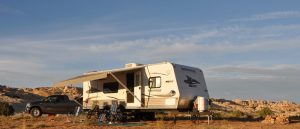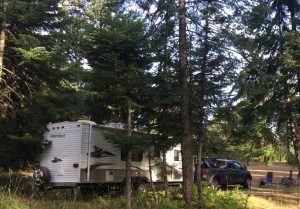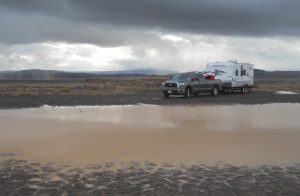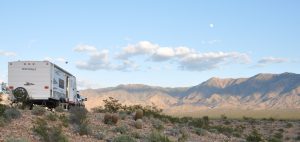You’ve arrived at an area where you would like to disperse camp. Unlike a developed campground with a predetermined space defined by lines or barriers to park your RV, you will likely have many choices on where and how to park and position your RV in the boondocks. How do you know which is the best spot for you and your RV?
Let’s look at seven things to consider:

Awning Facing West to Block the Afternoon Sun
– Sun and shade: Will you want your rig in the sun to warm things up, or in the shade to keep it cool? Maybe a combination of morning sun to warm your rig during brisk mornings and shade provided by a tree or hillside to keep your RV cool in the afternoon heat. In scorching heat it’s best to face the patio awning to the south or west and to keep the refrigerator side of the RV facing north. For those of us with solar panels on the roof, we may opt for full sunshine even in hotter climates.

Use Trees for Shade
– Communications: Is there cell phone service where you plan to park? Many times parking around a corner or over a rise will make all the difference. Look for cell phone towers on distant hills. A line of sight typically assures service. Higher obstructions like trees or steep hill sides located to the southeast of your RV will also be a consideration if you rely on satellite for receiving TV stations.
– Level: How hard will it be for you to level your RV at the chosen site? If the site slopes considerably side to side, try to locate your entry steps to the uphill side to avoid a big last step to reach the ground.
– Hazards: Is there anything that might cause damage to your RV? Beware of low hanging branches or dead trees that might fall during a windstorm. When parking along a steep slope beware of rocks that could dislodge above you. Are there any ground clearance impediments that might inflict damage to the underside of your RV when maneuvering into the site?
– Drainage: Will your chosen campsite drain well if it rains? Which way (side to side) should the awning be sloped to drain the resulting run off away from your RV? If camping in the desert, will your chosen campsite be safe in the event of a flash flood?

Park on High Ground to Avoid Surprises Like This
– Wind direction: Which way does the prevailing wind blow? Can you use it to your advantage? Things to consider are: Smoke from a campfire, cooling the RV and using the RV to shield you from the wind when sitting outdoors. Aim your RV into the wind if high winds are expected.
– View: How can you maximize the view of your campsite? Many times it’s as simple as parking on the highest place available or along the edge of a mountain stream or the perimeter of a high plateau. Aligning views with the RVs picture windows and your favorite seat is always a winning combination.

The Edge of a Desert Plateau Can Provide Stunning Views
Just like real estate, good dispersed camping sites are all about location, location, location. Enjoy!

Leave a Reply